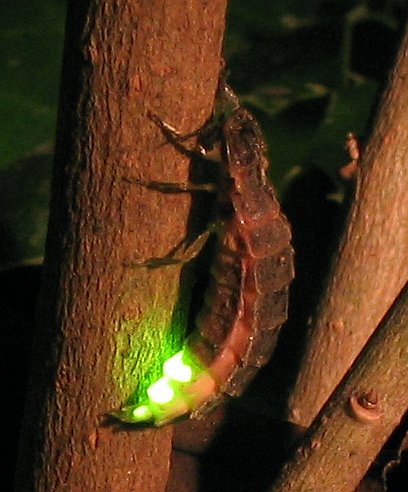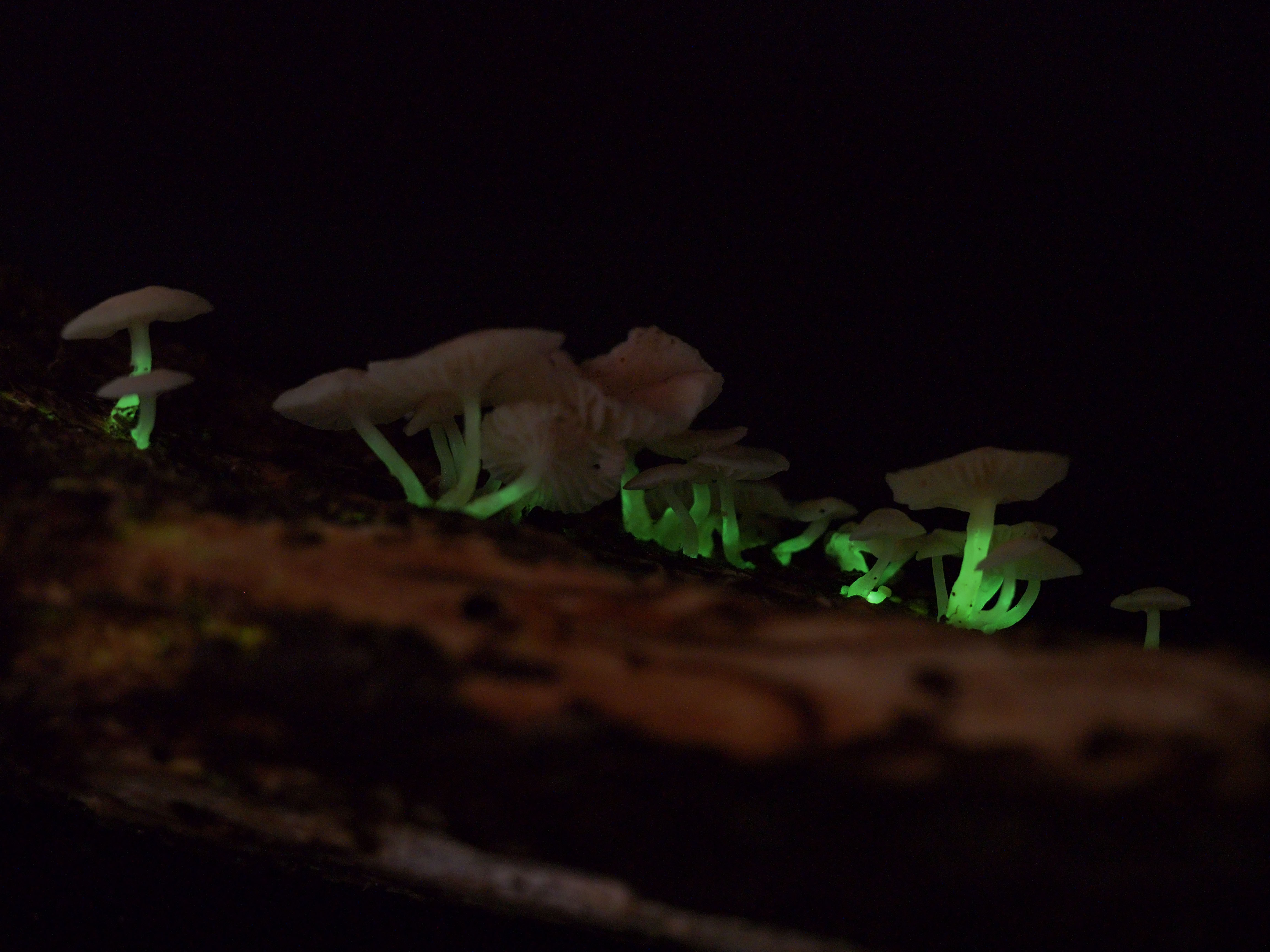|
Omphalotus Flagelliformis
''Omphalotus flagelliformis'' is a bioluminescent fungus native to Yunnan Province in southwestern China. Fruitbodies are reddish-brown to brown, with convex, flattened, or funnel-shaped caps typically in diameter. Described as new to science in 2013, the type collection was found the year previous in Kunming Botanical Garden at an elevation of . It was fruiting in a cluster around the base of a tree identified as being in the family Fagaceae. Molecular analysis suggests that ''Omphalotus flagelliformis'' is closely related to '' O. illudens'' and '' O. mexicanus''. The specific epithet ''flagelliformis'' refers to the "flagelliform" (long, slender, and flexible) appendages of the cheilocystidia. See also *List of bioluminescent fungi ] Found largely in temperate and tropical climates, currently there are more than 112 known species of bioluminescent fungi, all of which are members of the order Agaricales (Basidiomycota) with one exceptional ascomycete belonging to ... [...More Info...] [...Related Items...] OR: [Wikipedia] [Google] [Baidu] |
Bioluminescent
Bioluminescence is the production and emission of light by living organisms. It is a form of chemiluminescence. Bioluminescence occurs widely in marine vertebrates and invertebrates, as well as in some Fungus, fungi, microorganisms including some bioluminescent bacteria, and terrestrial arthropods such as Firefly, fireflies. In some animals, the light is bacteriogenic, produced by symbiosis, symbiotic bacteria such as those from the genus ''Vibrio''; in others, it is autogenic, produced by the animals themselves. In a general sense, the principal chemical reaction in bioluminescence involves a light-emitting molecule and an enzyme, generally called luciferin and luciferase, respectively. Because these are generic names, luciferins and luciferases are often distinguished by the species or group, e.g. firefly luciferin. In all characterized cases, the enzyme Catalysis, catalyzes the Redox, oxidation of the luciferin. In some species, the luciferase requires other Cofactor (bio ... [...More Info...] [...Related Items...] OR: [Wikipedia] [Google] [Baidu] |
Omphalotus Mexicanus
''Omphalotus mexicanus'' is a gilled basidiomycete mushroom in the family Marasmiaceae. Found in Mexico, it was described as new to science in 1984. Fruit bodies contain the compounds illudin The illudins are a family of sesquiterpenes with antitumor antibiotic properties produced by some mushrooms. In their isolated form, illudins show selective toxicity for myelocytic leukemia and other carcinoma cells. Illudins are highly toxic, w ... S and illudin M. Found in the highlands of Mexico and Central America, its fruiting bodies are an unusual dark blue tinted with yellow. References External links * {{Taxonbar, from=Q7090733 mexicanus Fungi described in 1984 Fungi of North America Taxa named by Gastón Guzmán ... [...More Info...] [...Related Items...] OR: [Wikipedia] [Google] [Baidu] |
Fungi Described In 2013
A fungus ( : fungi or funguses) is any member of the group of eukaryotic organisms that includes microorganisms such as yeasts and molds, as well as the more familiar mushrooms. These organisms are classified as a kingdom, separately from the other eukaryotic kingdoms, which by one traditional classification include Plantae, Animalia, Protozoa, and Chromista. A characteristic that places fungi in a different kingdom from plants, bacteria, and some protists is chitin in their cell walls. Fungi, like animals, are heterotrophs; they acquire their food by absorbing dissolved molecules, typically by secreting digestive enzymes into their environment. Fungi do not photosynthesize. Growth is their means of mobility, except for spores (a few of which are flagellated), which may travel through the air or water. Fungi are the principal decomposers in ecological systems. These and other differences place fungi in a single group of related organisms, named the ''Eumycota'' (''true f ... [...More Info...] [...Related Items...] OR: [Wikipedia] [Google] [Baidu] |
Poisonous Fungi
This is a compendium of poisonous fungi. See also mushroom poisoning. List of toxic mushroom species ''There are poisonous fungus species listed below.'' List of suspicious mushroom species See also *List of deadly fungi *List of poisonous animals *List of poisonous plants *Mushroom poisoning * Mycotoxicology *Mycotoxin A mycotoxin (from the Greek μύκης , "fungus" and τοξίνη , "toxin") is a toxic secondary metabolite produced by organisms of kingdom Fungi and is capable of causing disease and death in both humans and other animals. The term 'mycotoxin' ... References External links *{{commons category-inline poisonous fungi, List of ... [...More Info...] [...Related Items...] OR: [Wikipedia] [Google] [Baidu] |
Omphalotus
''Omphalotus'' is a genus of basidiomycete mushroom, in the family Marasmiaceae, formally circumscribed by Victor Fayod in 1889. Members have the traditional cap and stem structure. They are saprobic, and fruit in clumps on the ground, adjacent to host trees. The best known and type species is the jack-o'-lantern mushroom ''(Omphalotus olearius)''. Species of ''Omphalotus'' have been mistaken for chanterelles. All ''Omphalotus'' species are presumed poisonous, causing gastrointestinal symptoms. Some ''Omphalotus'' species have bioluminescent properties. Taxonomy Victor Fayod originally erected the genus with '' Pleurotus olearius'' and '' P. eryngii'' as its principal species in 1889, placing it in a ''tribus'' ("alliance") with the genera '' Pleurotus'' and '' Pleurotellus''. The relationships of the genus have become clearer with genetic analysis. Rolf Singer placed it and the related ''Lampteromyces'' in the Boletales due to the presence of the pigment variegatic a ... [...More Info...] [...Related Items...] OR: [Wikipedia] [Google] [Baidu] |
Bioluminescent Fungi
Bioluminescence is the production and emission of light by living organisms. It is a form of chemiluminescence. Bioluminescence occurs widely in marine vertebrates and invertebrates, as well as in some fungi, microorganisms including some bioluminescent bacteria, and terrestrial arthropods such as fireflies. In some animals, the light is bacteriogenic, produced by symbiotic bacteria such as those from the genus ''Vibrio''; in others, it is autogenic, produced by the animals themselves. In a general sense, the principal chemical reaction in bioluminescence involves a light-emitting molecule and an enzyme, generally called luciferin and luciferase, respectively. Because these are generic names, luciferins and luciferases are often distinguished by the species or group, e.g. firefly luciferin. In all characterized cases, the enzyme catalyzes the oxidation of the luciferin. In some species, the luciferase requires other cofactors, such as calcium or magnesium ions, and sometime ... [...More Info...] [...Related Items...] OR: [Wikipedia] [Google] [Baidu] |
List Of Bioluminescent Fungi
] Found largely in temperate and tropical climates, currently there are more than 112 known species of bioluminescent fungi, all of which are members of the order Agaricales (Basidiomycota) with one exceptional ascomycete belonging to the order Xylariales. All known bioluminescent Agaricales are mushroom-forming, white-spored agarics that belong to four distinct evolutionary lineages. The Omphalotus lineage (comprising the genera ''Omphalotus'' and '' Neonothopanus'') contains 12 species, the ''Armillaria'' lineage has 10 known species, while the Mycenoid lineage ('' Favolachia, Mycena'', '' Panellus'', '' Prunulus'', '' Roridomyces'') has more than 50 species. The recently discovered Lucentipes lineage contains two species, ''Mycena lucentipes'' and '' Gerronema viridilucens'', which belong to a family that has not yet been formally named. ''Armillaria mellea'' is the most widely distributed of the luminescent fungi, found across Asia, Europe, North America, and South Africa. Bi ... [...More Info...] [...Related Items...] OR: [Wikipedia] [Google] [Baidu] |
Cheilocystidia
A cystidium (plural cystidia) is a relatively large cell found on the sporocarp of a basidiomycete (for example, on the surface of a mushroom gill), often between clusters of basidia. Since cystidia have highly varied and distinct shapes that are often unique to a particular species or genus, they are a useful micromorphological characteristic in the identification of basidiomycetes. In general, the adaptive significance of cystidia is not well understood. Classification of cystidia By position Cystidia may occur on the edge of a lamella (or analogous hymenophoral structure) (cheilocystidia), on the face of a lamella (pleurocystidia), on the surface of the cap (dermatocystidia or pileocystidia), on the margin of the cap (circumcystidia) or on the stipe (caulocystidia). Especially the pleurocystidia and cheilocystidia are important for identification within many genera. Sometimes the cheilocystidia give the gill edge a distinct colour which is visible to the naked eye or wit ... [...More Info...] [...Related Items...] OR: [Wikipedia] [Google] [Baidu] |
Botanical Name
A botanical name is a formal scientific name conforming to the '' International Code of Nomenclature for algae, fungi, and plants'' (ICN) and, if it concerns a plant cultigen, the additional cultivar or Group epithets must conform to the ''International Code of Nomenclature for Cultivated Plants'' (ICNCP). The code of nomenclature covers "all organisms traditionally treated as algae, fungi, or plants, whether fossil or non-fossil, including blue-green algae ( Cyanobacteria), chytrids, oomycetes, slime moulds and photosynthetic protists with their taxonomically related non-photosynthetic groups (but excluding Microsporidia)." The purpose of a formal name is to have a single name that is accepted and used worldwide for a particular plant or plant group. For example, the botanical name ''Bellis perennis'' denotes a plant species which is native to most of the countries of Europe and the Middle East, where it has accumulated various names in many languages. Later, the plant was intro ... [...More Info...] [...Related Items...] OR: [Wikipedia] [Google] [Baidu] |
Omphalotus Illudens
''Omphalotus illudens'', commonly known as the eastern jack-o'lantern mushroom, is a large, orange mushroom that is often found in clumps on decaying stumps, buried roots, or at the base of hardwood trees in eastern North America. Its gills often exhibit a weak green bioluminescence when fresh. This green glow has been mentioned in several journal articles, which state that the phenomenon can persist up to 40-50 hours after the mushroom has been picked. It is believed that this display serves to attract insects to the mushroom’s gills during nighttime, which can then distribute its spores across a wider area. ''Omphalotus illudens'' is sometimes confused with edible chanterelles, but can be distinguished by its thicker, fleshier appearance, tendency to form large clusters, and clearly separated caps when young. Unlike chanterelles, the Eastern Jack-o’-lantern is poisonous to humans when eaten, whether raw or cooked, and typically causes vomiting, cramps, and diarrhea. Altho ... [...More Info...] [...Related Items...] OR: [Wikipedia] [Google] [Baidu] |
Yunnan Province
Yunnan , () is a landlocked province in the southwest of the People's Republic of China. The province spans approximately and has a population of 48.3 million (as of 2018). The capital of the province is Kunming. The province borders the Chinese provinces of Guizhou, Sichuan, autonomous regions of Guangxi, and Tibet Autonomous Region, Tibet as well as Southeast Asian countries: Vietnam, Laos, and Myanmar. Yunnan is China's fourth least developed province based on disposable income per capita in 2014. Yunnan is situated in a mountainous area, with high elevations in the northwest and low elevations in the southeast. Most of the population lives in the eastern part of the province. In the west, the altitude can vary from the mountain peaks to river valleys by as much as . Yunnan is rich in natural resources and has the largest diversity of plant life in China. Of the approximately 30,000 species of Vascular plant, higher plants in China, Yunnan has perhaps 17,000 or more. Yun ... [...More Info...] [...Related Items...] OR: [Wikipedia] [Google] [Baidu] |
Molecular Phylogenetics
Molecular phylogenetics () is the branch of phylogeny that analyzes genetic, hereditary molecular differences, predominantly in DNA sequences, to gain information on an organism's evolutionary relationships. From these analyses, it is possible to determine the processes by which diversity among species has been achieved. The result of a molecular phylogenetic analysis is expressed in a phylogenetic tree. Molecular phylogenetics is one aspect of molecular systematics, a broader term that also includes the use of molecular data in taxonomy and biogeography. Molecular phylogenetics and molecular evolution correlate. Molecular evolution is the process of selective changes (mutations) at a molecular level (genes, proteins, etc.) throughout various branches in the tree of life (evolution). Molecular phylogenetics makes inferences of the evolutionary relationships that arise due to molecular evolution and results in the construction of a phylogenetic tree. History The theoretical frame ... [...More Info...] [...Related Items...] OR: [Wikipedia] [Google] [Baidu] |



_Bresinsky_&_Besl_1018098506.jpg)



.jpg)

